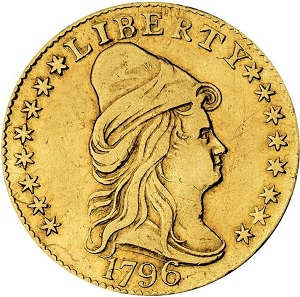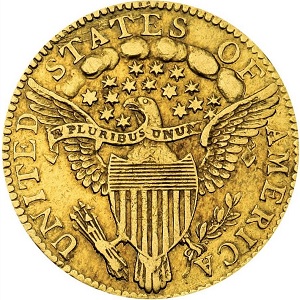1796 Capped Bust $2.50 Quarter Eagle, Stars
The Mint Act of 1792 (also called the Coinage Act) approved the production of three gold coin denominations at the newly established United States Mint: the $10 eagle, $5 half eagle, and lastly, the $2.50 quarter eagle.(1)
During the Mint’s infancy years, gold and silver coins were stuck according to the wishes of bullion depositors from the public. The $5 half eagle was the most demanded denomination for domestic business purposes, while the $10 eagle was most useful for international transactions.
The $2.50 quarter eagle, however, had difficulty finding a role during a time when the average worker earned only a few dollars weekly.
In the wake of poor demand, quarter eagles were sporadically minted in very small numbers before production was halted indefinitely after 1808.
The first 1796 quarter eagles featured Robert Scot’s capped bust to right, without obverse stars. The reverse displayed a large, heraldic eagle. Researchers believe 963 pieces of this type were made. The obverse was modified to include stars on both sides of Miss Liberty. Only 432 of the “with stars” design were struck.(2)
Sadly, for modern collectors, the small supply of early U.S. gold coins was further diminished during the 1820’s and 1830’s, when bullion profiteers melted down a considerable number of them.(3)
Of the 1796 Capped Bust quarter eagle with stars, only 41 examples are estimated to survive today, qualifying it as one of rarest and most valuable coins in U.S. numismatics.(4)
The value trend charts for the 1796 illustrate an unrelenting one-way path upward, exactly as should be expected for this incredible, historically significant coin.
| Estimated survivors in all grades: 41 ?
The survivor estimate from PCGS represents an average of one or more experts' opinions as to how many examples survive of a particular coin in all grades. Survival estimates include coins that are raw, certified by PCGS, and certified by other grading services. Learn more at PCGS. |
| PCGS Rarity Scale: 8.6 ?
The 'PCGS CoinFacts Rarity Scale' assesses the relative rarity of all U.S. coins, based on estimated surviving examples. The scale runs from 1.0 to 10.0. The higher the number, the rarer the coin.
Learn more at PCGS. |
| Click HERE to check for availability on eBay** |
Preview of eBay selection (this rarity usually is not available):
 |
 |
| Trendline Avg = 15.56 | GOOD |
Historic Value Trend Charts:
| Last updated 7-8-24 | Return to Key Date Coin List | |
| Compare to Common Date Coin of Same Type | ||
|
|
||
| Download Charts to Your Computer | ||
Sources
1. Stack's Bowers Galleries. 1796 Stars Obverse Quarter Eagle. Aug 2021 Auction.
2. Bowers, Q. David. The History of United States Coinage. Los Angeles, CA: Bowers and Ruddy Galleries, Inc., 1979.
3. Stack's Bowers Galleries. 1796 Stars Obverse Quarter Eagle. Aug 2021 Auction.
4. PCGS. 1796 $2.50 Stars (Regular Strike).
**Many very fine coin dealers sell on eBay. At any point in time, there may be over one million search results for United States coins. This includes quite a few of the recommendations on our Key Date Coin List.
If you’re thinking about purchasing a rare coin, eBay is certainly worth a look. For your convenience, the links from this site to eBay are coded to bring up only coins certified by PCGS and NGC.
As is always, always the case, never buy a valuable coin from a seller whose trustworthiness cannot be verified. Learn more about this at our chapter Best Places to Buy Coins, which also has a section on doing business on eBay.
In the interest of full disclosure, Rare Coins 101 receives a small commission anytime someone connects to eBay from this site and purchases something.
Coin images by Stack's Bowers Galleries.


